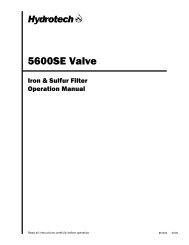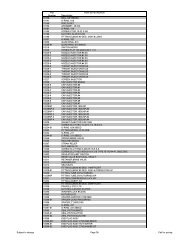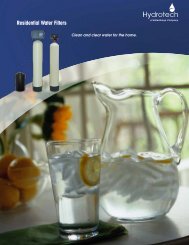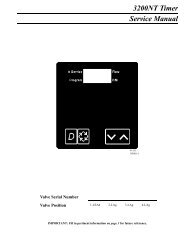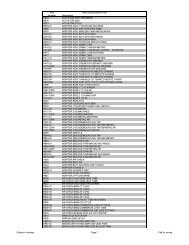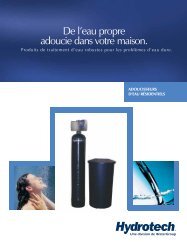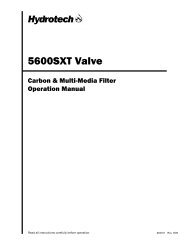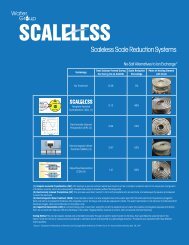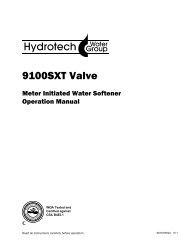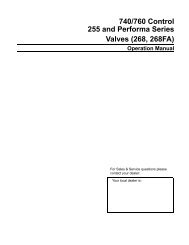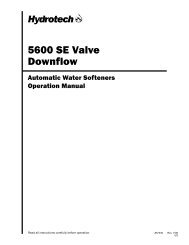HY US 01 Introduction.qxp - Hydrotech
HY US 01 Introduction.qxp - Hydrotech
HY US 01 Introduction.qxp - Hydrotech
Create successful ePaper yourself
Turn your PDF publications into a flip-book with our unique Google optimized e-Paper software.
Nanometer - A measure of a wavelength in the<br />
electromagnetic spectrum. One nanometer equals 10 9<br />
meter.<br />
Neutralization - In general, the addition of either an acid<br />
or a base to a solution as required to produce a neutral<br />
solution. The use of alkaline or basic materials to<br />
neutralize the acidity of some waters is common practice<br />
in water conditioning.<br />
Organic Iron - A ferrous iron molecule which is<br />
enveloped in an organically complex molecule that<br />
resists oxidation. May be present in water that contains a<br />
great deal of colored colloidal turbidity.<br />
Organics - Any of the compounds whose chemical<br />
structure is based on carbon (e.g. carbon dioxide, wood,<br />
sugar, protein, plastics, methane, THM, TCE, etc.)<br />
Osmosis - A process of diffusion of a solvent, such as<br />
water through a semipermeable membrane, which will<br />
transmit the solvent but impede most dissolved<br />
substances. The normal flow of solvent is from the dilute<br />
solution to the concentrated solution. (See Reverse<br />
Osmosis.)<br />
Osmotic Pressure - The pressure created by the<br />
tendency of water to flow in osmosis. Every 100 ppm of<br />
TDS generates about 1 pound per square inch (psi) of<br />
osmotic pressure. This osmotic pressure must first be<br />
overcome by the water pressure for the reverse osmosis<br />
membrane to be effective.<br />
Oxidation - A chemical process in which electrons are<br />
removed from an atom, ion or compound. The addition of<br />
oxygen is a specific form of oxidation. Combustion is an<br />
extremely rapid form of oxidation while the rusting of iron<br />
is a slow form.<br />
Oxidizing Agents - Any substance that oxidizes another<br />
substance and is itself reduced in the process. Common<br />
examples include: oxygen, chlorine, potassium<br />
permanganate, hydrogen peroxide, iodine and ozone.<br />
Ozone (O3) - An unstable form of oxygen occurring<br />
naturally in the upper atmosphere or artificially produced<br />
because of its strong oxidizing or disinfection<br />
characteristics.<br />
Particle Size - As used in industry standards, the size of<br />
a particle suspended in water as determined by its<br />
smallest dimension, usually expressed in microns.<br />
Parts per Million (ppm) - A common basis for reporting<br />
the results of water and waste water analysis, indicating<br />
the number of parts by weight of water or other solvent.<br />
In dilute water solutions, on part per million is practically<br />
equal to one milligram per liter, which is the preferred<br />
unit. 17.12 ppm equals one grain per U.S. gallon.<br />
Pathogen - An organism which may cause disease.<br />
PCB - Polychlorinated Biphenyls - A highly toxic<br />
organic contaminant found in water supplies which is<br />
suspected of causing cancer in humans.<br />
pH - or the potential of hydrogen ion activity or<br />
concentration. pH is a measure of the intensity of the<br />
acidity or alkalinity of water on a scale from 0 to 14, with<br />
7 being neutral. When acidity is increased, the hydrogen<br />
ion concentration increases, resulting in a lower pH<br />
value. Similarly, when alkalinity is increased, the<br />
hydrogen ion concentration decreases, resulting in<br />
higher pH. The pH value is an exponential function so<br />
that pH is 10 times as alkaline as pH 9 and 100 times as<br />
alkaline as pH 8. Similarly, a pH 4 is 100 times as acid<br />
as pH 6 and 1000 times as acid as pH 7.<br />
Potassium Chloride (KCI) - a compound consisting of<br />
potassium and chloride, becoming increasingly popular<br />
as a substitute for sodium chloride in regenerating water<br />
softeners.<br />
Potassium Permanganate (KMnO4) - A powerful<br />
oxidizing agent consisting of dark purple crystals with<br />
blue metallic sheen. Explosive in contact with sulfuric<br />
acid or hydrogen peroxide. Increases flammability of<br />
combustible materials. Used to renew the black<br />
manganese oxide coating on greensand media.<br />
Precipitate - To cause a dissolved substance to form a<br />
solid particle which can be removed by settling or filtering<br />
such as in the removal of dissolved iron by oxidation,<br />
precipitation and filtration. The term is also used to refer<br />
to the solid formed and the condensation of water in the<br />
atmosphere to form rain or snow.<br />
Pre-treatment - Whatever alterations of the raw feed<br />
water are required to prevent damage to the reverse<br />
osmosis membrane.<br />
Product Water - The pure water that has been<br />
separated from the feed water stream by the reverse<br />
osmosis membrane.<br />
Pumping Rate - The amount of actual water that can be<br />
drawn from a pressure system expressed in gallons per<br />
minute (gpm) obtained by dividing the drawdown<br />
(gallons) by the cycle time (seconds) and multiplying the<br />
result by 60 (seconds.)<br />
Quartz - A high grade of glass made using quartz sand.<br />
310 <strong>Hydrotech</strong>



